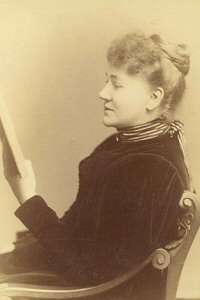Florence Marryat

Florence Marryat (9 July 1833 – 27 October 1899) was a British author and actress. The daughter of author Capt. Frederick Marryat and his wife Catherine, she was particularly known for her sensational novels and her involvement with several celebrated spiritual mediums of the late 19th century. Her works include There is No Death (1891) and The Spirit World (1894). She was a prolific author, writing over 70 books, newspaper and magazine articles, short stories and works for the stage. From 1876 to 1890, she had a performing career, at first writing and performing a comic touring piano sketch entertainment, together with George Grossmith and later performing in dramas, comedies, comic opera with a D'Oyly Carte Opera Company, her own one-woman show, and appearing as a lecturer, dramatic reader and public entertainer. During the 1890s, she ran a school of Journalism and Literary Art.
Early life
Marryat was born in Brighton, Sussex, in 1833, daughter of author and naval Captain Frederick Marryat and his wife, Catherine (nee Shairp). Her parents separated when Marryat was young; her childhood was divided between her parents' residences, where she was privately educated.[1]
Shortly before her 21st birthday, she wed Thomas Ross Church, an officer in the Madras staff corps of the British Army in India; they spent the first seven years of their married life travelling India extensively before she returned to England in 1860 without her husband, who apparently visited only occasionally. She had eight children with Church, three of them while in India.[2]
Career
Marryat wrote her first novel, Love’s Conflict (1865), while her young children were suffering from scarlet fever, to distract herself from “sad thoughts”. The novel met with modest success and was followed by Too Good for Him and Woman Against Woman in the same year. In 1872, she wrote a biography of her father, Life and Letters of Captain Marryat. From 1872 to 1876, in addition to writing for newspapers and magazines, she edited the monthly magazine London Society.[1][3]
By the mid-1870s Marryat was an internationally successful author and was living together with her future husband, Colonel Francis Lean of the Royal Marine Light Infantry. Church eventually sued for divorce in 1878, citing his wife’s adultery as the grounds.[1] From 1876 to 1877, she collaborated with George Grossmith, writing and performing a comic touring entertainment called Entre Nous ("Between you and me"). This piece consisted of a series of piano sketches, alternating with scenes and costumed recitations, including a two-person "satirical musical sketch", really a short comic opera, by Grossmith called Cups and Saucers.[4] Marryat and her husband divorced in 1879; later that year, she wed Colonel Lean, but they divorced only a year later, in 1880.[3]
At the age of 43, in 1881, Marryat returned to the stage, playing the role of Hephzibah Horton in a drama she wrote based on her novel Her World Against a Lie. The next year, she joined a D'Oyly Carte Opera Company touring company in Gilbert and Sullivan's Patience, playing the role of Lady Jane. In 1884 she played Queen Altemire in a revival of W. S. Gilbert's fairy comedy The Palace of Truth in London with Herbert Beerbohm Tree.[3] In 1886, Marryat wrote a lighthearted book about her travels in the United States called Tom Tiddler's Ground. She later appeared in her own one-woman show, Love Letters, and appeared as a lecturer, dramatic reader and public entertainer. She continued performing until 1890, when she played Cassandra Doolittle in an operetta called The Dear Departed.[3]
Last years and death
During the 1890s, Marryat ran a school of Journalism and Literary Art.[1] She continued writing for the rest of her life, and some of her best known books were her late-career writings on spiritualism, and included There Is No Death (1891), The Spirit World (1894) and A Soul on Fire. She influenced wiccan Gerald Gardner in his youth.[5]
Marryat died in 1899 from diabetes and pneumonia[6] and is buried in Kensal Green Cemetery in London.[2]
Works
Marryat published 68 novels before her death, as well as various non-fiction works such as The Life and Letters of Captain Marryat (1872) and Gup (1868), an account of garrison life in India. She also wrote newspaper and magazine articles, short stories and works for the stage. Her works treated such then-controversial themes as marital cruelty, adultery, alcoholism and spiritualism.[7] There is No Death and The Spirit World give accounts of séances she attended.[2]
Novels
|
Short story collections
Children’s stories
Collaborations
Plays
Memoirs
Spiritualism
|
References
- 1 2 3 4 Pope, Catherine. "Florence Marryat: Eminent Victorian". Florencemarryat.org, accessed 19 April 2011
- 1 2 3 Neisius, Jean G. "Florence Marryat." Oxford Dictionary of National Biography.
- 1 2 3 4 Stone, David. "Florence Marryat". The Gilbert and Sullivan Archive, 27 August 2001, accessed 19 April 2011
- ↑ Grossmith, George (1888). A Society Clown: Reminiscences. Bristol/London: Arrowsmith. Chapter 5.
- ↑ Judika Illes, The Element Encyclopedia of Witchcraft, HarperElement 2005, p 732
- ↑ Florence Marryat – Life
- ↑ Hall, Trevor H. (1963). The spiritualists: the story of Florence Cook and William Crookes. Helix Press. pp. 64–67.
Sources
 Herbermann, Charles, ed. (1913). "Florence Marryat". Catholic Encyclopedia. New York: Robert Appleton Company.
Herbermann, Charles, ed. (1913). "Florence Marryat". Catholic Encyclopedia. New York: Robert Appleton Company. Lee, Elizabeth (1901). "Marryat, Florence". In Sidney Lee. Dictionary of National Biography, 1901 supplement. London: Smith, Elder & Co.
Lee, Elizabeth (1901). "Marryat, Florence". In Sidney Lee. Dictionary of National Biography, 1901 supplement. London: Smith, Elder & Co. - Fodor, Nandor. "Florence Marryat," An Encyclopaedia of Psychic Science (1934).
External links
- Florence Marryat – Eminent Victorian
- Florence Marryat (1833-1899)
- Works by Florence Marryat at Project Gutenberg
- Works by or about Florence Marryat at Internet Archive
- Works by Florence Marryat at LibriVox (public domain audiobooks)
